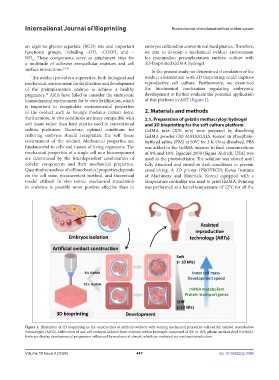Page 455 - IJB-10-4
P. 455
International Journal of Bioprinting Biomechanical mimic-based artificial oviduct system
an arginine-glycine-aspartate (RGD) site and important embryos cultured on conventional hard plastics. Therefore,
functional groups, including –OH, –COOH, and – we aim to develop a mechanical oviduct environment
NH . These components serve as attachment sites for for mammalian preimplantation embryo culture with
2
a multitude of adhesive extracellular matrices and cell 3D-bioprinted GelMA hydrogel.
surface interactions. 29,30 In the present study, we determined if emulation of the
The oviduct provides a supportive, both biological and oviduct environment with 3D bioprinting could improve
mechanical, environment for fertilization and development reproductive cell culture. Furthermore, we examined
of the preimplantation embryo to achieve a healthy the biochemical mechanism regulating embryonic
pregnancy. ARTs have failed to consider the embryonic development to further evaluate the potential application
18
biomechanical environment for in vitro fertilization, which of this platform in ART (Figure 1).
is important to recapitulate environmental properties
of the oviduct such as Young’s modulus contact force. 2. Materials and methods
Furthermore, in vivo conditions are more compatible with 2.1. Preparation of gelatin methacryloyl hydrogel
soft tissue rather than hard plastics used in conventional and 3D bioprinting for the soft culture platform
culture platforms. Therefore, optimal conditions for GelMA inks (20% w/v) were prepared by dissolving
culturing embryos should recapitulate the soft tissue GelMA powder (3D MATERIALS, Korea) in phosphate-
environment of the oviduct. Mechanical properties are buffered saline (PBS) at 50°C for 3 h. Once dissolved, PBS
fundamental to cells and tissues of living organisms. The was added to the GelMA mixture to final concentrations
mechanical properties of a single cell as a biocomponent of 8% and 10%. Irgacure 2959 (Sigma-Aldrich; USA) was
are determined by the interdependent combination of used as the photoinitiator. The solution was stirred until
cellular components and their mechanical properties. fully dissolved and stored in dark conditions to prevent
Quantitative analysis of cell mechanical properties depends crosslinking. A 3D printer (PROTECH; Korea Institute
on the cell state, measurement method, and theoretical of Machinery and Materials, Korea) equipped with a
model utilized. In vivo mimic mechanical stimulation temperature controller was used to print GelMA. Printing
in embryos is possibly more positive effective than in was performed at a barrel temperature of 22°C for all the
Figure 1. Illustration of 3D bioprinting in the construction of artificial oviducts with varying mechanical properties tailored for assisted reproductive
technologies (ARTs). Cultivation of one-cell embryos isolated from oviducts within hydrogels composed of 8% or 10% gelatin methacryloyl (GelMA).
Embryos display developmental progression influenced by mechanical stimuli, which are mediated via mechanotransduction.
Volume 10 Issue 4 (2024) 447 doi: 10.36922/ijb.3346

